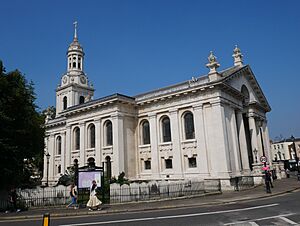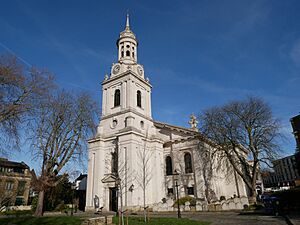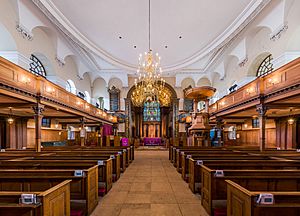St Alfege Church, Greenwich facts for kids
Quick facts for kids St Alfege Church |
|
|---|---|

The church seen from the southeast
|
|
| Location | London, SE10 |
| Country | England |
| Denomination | Church of England |
| History | |
| Dedicated | 1718 |
| Architecture | |
| Heritage designation | Grade I |
| Years built | 1714 (present) |
| Administration | |
| Diocese | Southwark |
St Alfege Church is a historic Anglican church located in the heart of Greenwich, London. This beautiful church has roots going back to medieval times. It was rebuilt between 1712 and 1714 by the famous architect Nicholas Hawksmoor.
Contents
A Look at Early History

The church is named after Alfege, who was an Archbishop of Canterbury. It is believed to be the exact spot where he was killed on April 19, 1012. This happened after Danish raiders captured him during the Siege of Canterbury the year before. The Danes brought him to their camp in Greenwich. They killed him when the large payment they demanded was not given.
The church was rebuilt around 1290. Later, in 1491, Henry VIII was baptized there as a baby.
The right to choose the church's priest was given to a monastery in Ghent during the 13th century. After some changes, this right eventually went to the King in 1530.
In 1710, a big storm caused the medieval church to fall down. Its base had become weak because of many burials both inside and outside the building.
The Church Today
After the old church collapsed, the current building was constructed. Money for the new church came from a special group called the Commission for Building Fifty New Churches. Nicholas Hawksmoor, one of the commission's architects, designed it.
This was the first church built by the commission. Work began in 1712 and the main construction finished in 1714. However, it was not officially opened until 1718. Edward Strong the Younger, a friend of Christopher Wren the Younger, built the church.
The church has a rectangular shape with a flat ceiling. A small curved area serves as the main worship space. The front of the church, facing the street, has a grand entrance with columns. A special design feature, where an arch cuts through the top part, was also used in Wren's plans for St Paul's Cathedral.
Large, flat columns decorate the rest of the church's outside walls. Some experts think Thomas Archer might have added these. On the north and south sides, large entrance areas stick out from the building. Steps lead up to the doors.
Hawksmoor had planned a tall tower for the west side, where the old tower stood. However, the commission did not want to pay for it. So, the medieval tower was kept. In 1730, John James updated its look and added a spire. Hawksmoor's original design for the tower, shown in a drawing from 1714, had an eight-sided top. He later used a similar design for another church.
The church's underground area was used as a shelter during World War II air raids. On March 19, 1941, during the Blitz, fire bombs hit the roof. This caused the roof to collapse and burn the inside of the church. The walls and tower remained standing, but much of the inside was destroyed. Sir Albert Richardson restored the church in 1953. As part of the restoration, special paintings of Mary and St John were added near the Cross in a side chapel. These were created by the artist Augustus Lunn.
Church Organs
The main organ in the church was put in place in 2001. It was moved from a chapel at Eton College and had some small changes. This organ was originally built in 1891 by Lewis & Co. It was later updated in 1927 and 1970.
There is also a smaller, movable organ with six stops. It is located in the north aisle. This organ was made around 1960 and later restored.
The Tallis Organ
The church's previous organ had a very long history. It dated back to the 16th century. At that time, St Alfege was known to have two organs.
The exact location of this old organ today is not known. However, a control panel for a three-manual organ is on display. This panel might include keys from the time of the famous composer Thomas Tallis. Tallis was buried in the old church in the 16th century.
The organ was repaired in 1706 and updated many times over the years. It was rebuilt and restored in 1875. By 1934, it had grown to 47 stops, which are controls that change the sound. It survived the bomb damage in 1941. It was rebuilt again in 1953 and then had 55 stops.
Today, the church is used for special events like "Founder's Day" for Addey and Stanhope School and The John Roan School.
Churchyards and Gardens
The church used to have two churchyards, which are burial grounds. Burials stopped there in 1853. In 1889, these areas were given to the local Greenwich board. The newer churchyard was turned into a garden and recreation area by landscape designer Fanny Wilkinson. It opened in 1889 and was renamed St Alfege Park. Wilkinson planted 500 trees there.
In 2015, a charity event was held in the churchyard. During the event, police arrived quickly. An attendee mentioned that people calmly continued drinking their tea. The police then went to the nearby St Alfege Park, where a person was arrested and a weapon was found.
Famous People Buried Here
Many notable people are buried in and around St Alfege Church. These include:
- The composer William Newark (died 1509).
- Richard Bower (died 1561), who was in charge of the Children of the Chapel Royal.
- The famous composer Thomas Tallis (died 1585).
- The courtier Elizabeth Roper (died 1658).
- The merchant Sir John Lethieullier (died 1719).
- The English explorer of Canada, Henry Kelsey (died 1724).
- General James Wolfe, who won a big battle in Canada but died during it in 1759.
- The actress Lavinia Fenton (died 1760).
- The politician Sir James Creed (died 1762).
Sarah Barrett Moulton, a schoolgirl from Jamaica, was buried here. She died at age twelve in 1795. She was the subject of the famous painting Pinkie, shown above. The painting was done just a year before she passed away. John Julius Angerstein (died 1823), a merchant and art collector, is also buried here. He was a church leader in the early 1800s.
St Alfege in Books
St Alfege Church appears in some famous books.
In Charles Dickens's novel Our Mutual Friend, a character named Bella Wilfer marries John Rokesmith in St Alfege Church.
In Tom McCarthy's novel C, a character hears laughter that reminds him of "liturgical chants and whispers echoing around St. Alfege's interior."
See also
 In Spanish: Iglesia de San Alfegio (Greenwich) para niños
In Spanish: Iglesia de San Alfegio (Greenwich) para niños





